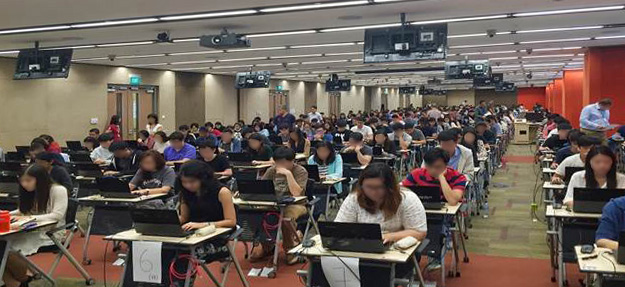
The students sat in neat rows facing their computers.
Unlike a computer laboratory with the click-clack of keyboards, all was silent.
The digital clock struck 10, and the e-examination began.
In January 2016, the Centre for Instructional Technology (CIT) and Computer Centre (CCE) facilitated a high-stakes e-exam at MD 1.
About 300 medical students sat for this e-exam, the main MBBS examination.
The students sat for the e-exam in one session, a first for the pioneering Yong Loo Lin School of Medicine (YLLSOM). The school held the first e-exam at NUS in 2007.
YLLSOM mooted e-exams to provide more realistic assessment scenarios.
E-exams allow for questions which involve high-resolution x-rays and electrocardiograms. Also, questions can include audio and video evidence.
Other benefits include question banking, marking efficiencies and reduction in paper logistics.
CIT concurred with the benefits and worked with YLLSOM to make e-exams a reality.
Currently, CIT uses ExamSoft, an e-exam software that locks down computers by restricting the internet connection, other software and external devices.
Logistical and technical limits meant that the school's previous e-exams took at least three sessions.
Space was a limiting factor.
The largest PC lab on campus could only accommodate about 100 students. A typical medicine cohort is about 300 students.
While technology enabled e-exams, it came with restrictions.
At the time, only wired LAN connections were stable and fast enough for e-exams.
Also, e-exams had to be taken on university-owned PCs for security and reliability.
Fast forward to 2016.
Several concurrent developments allowed a single-session e-exam.
The new MD 1 building features a hall that can accommodate an entire cohort of medicine students.
Another important aspect is CCE's implementation of a high-density wireless (HD Wi-Fi) network in the MD 1 exam hall.
The HD Wi-Fi network enables a stable and high-bandwidth connection for each of the 300 or so students taking the exam.
At the same time, improvements in e-exam software allows students to use their own laptops.
YLLSOM considers the single-seating e-exam pilot to be a success.
Less than 1% of students experienced technical issues. Of these, none were insurmountable.
The HD Wi-Fi network performed as well as a wired LAN connection. Exam candidates did not encounter network errors or delays.
YLLSOM will continue using e-exams for the main and supplementary MBBS exams.
Medical students have also been taking End of Posting Tests (EOPT), Cumulative Assessments (CAs), as well as formative and summative assessments using e-exams.
Other than YLLSOM, CIT works with the Faculty of Arts & Social Sciences, Faculty of Law and Faculty of Science to conduct e-exams for various modules.

